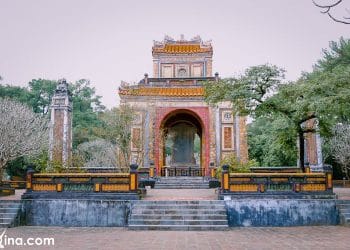Updated: 11/20/2019
Contents
Hue imperial citadel, an ample space, is the former imperial capital of Vietnam and also the most central place of the Nguyen Dynasty. Today, there are the remains of buildings, castles, temples and palaces with uniquely fine-art decoration. It is the perfect destination for travellers who are in search of cultural values. Regarded as one UNESCO-listed World Heritage Site, the Imperial Citadel of Hue is a world of ancient history and nearly unspoiled architectural beauty.
Hue imperial citadel was built in 1805 under the Gia Long emperor and completed in the period of Minh Mang King. The grounds of the Imperial City are wholly protected by fortified ramparts 2 kilometers by 2 kilometers. These grounds are also ringed by a moat. This moat uses the water directed from the Huong River through a series of gates. This enclosure is the citadel or Kinh Thanh. The Imperial City is situated inside the citadel, with a perimeter wall some 2.5 kilometers long.
Someone said: “A normal artist cannot build this work. It must be a person who has a profound understanding of the culture and history of Hue. But that was not enough; he must have a great love for Hue”. Truly, Hue imperial citadel is the beautiful architecture, the efforts and difficulty in construction. Thus, it is the reason why the Nguyen Dynasty spent 30 years to complete this building with special symbols below.
Ngo Mon – the distinctive mark of Hue history

Ngo Mon, the main gate of the Imperial City, lies in the south of Hue imperial citadel. It is the vast architectural complex looking like a luxurious castle in a long-distance, yet it also brings the beauty harmonious with nature and Hue people’s feeling and soul. In the ground is the hierarchy system of flagstones, next to is Ngu Phung floor. Ngu Phung floor is a large space. Tourists can feel released and comfortable in any weather conditions. It is also the open space for tourists to watch the full view and experience Hue’s historical and cultural stamp. Besides carved pictures or royal palace gates of Ngu Phung floor, you can see the entire imperial city and the ancient imperial for the whole view of Hue Imperial citadel in deep blue Huong Riverbank.
Thai Hoa palace – the icon of the Nguyen Dynasty’ s power
Thai Hoa palace is located on Hue inner court, the place of Nguyen Kings’ s enthroning. It is considered the center of Hue imperial citadel, the former center of the country. It symbolizes the power of the Nguyen emperors. The palace was used to serve the important conferences of the imperial. In Thai Hoa palace, Nguyen kings’ throne is still well kept.
Duyet Thi Duong – the place of contemplating court music
Duyet Thi Duong inside Forbidden city, is the theater for Kings, princes, mandarins of Hue imperial citadel to watch ancient Tuong performances. It is also the oldest theater of Vietnam theaters. Duyet Thi Duong was in restoration and was active to perform “nhã nhạc of Huế court (Nhã nhạc cung đình Huế)” for attracting tourists.
Ky Dai –the central icon of Hue ancient capital

Ky Dai, located on the central south of Hue Imperial citadel, belongs to the Nam Chanh fort and also is the place to hang the court’s flag. Ky Dai has the respectively large structure: flagpole and flag tower.
Bao Vinh – “secret” ancient town in the central of Hue imperial citadel
In the Hue tourism map, Bao Vinh old town may be a strange name to many visitors. From the 17th century to the 19th century, Bao Vinh was considered the most prominent bustling market not only in Hue imperial citadel but also in Dang Trong. Bap Vinh had 39 houses with the age of 150 to 200 years, but they are now mostly damaged due to time and weather conditions, and only 15 homes left. However, Bao Vinh also brings the fairy beauty of the old period, which makes people feel so strange. The house owners are social and friendly because they are willing to be your local guide when you show respect and passion for exploring ancient houses.
The layout of Hue Imperial Citadel and Imperial Place are represented lively and physically and bear the impressive points of the French architecture style during the French colonial. It shows the impressive physical layout of Hue Imperial Citadel and Imperial Palace. Through the architecture of Hue Imperial Citadel, tourists can have a chance to discover and experience those unique structures which are still somehow well preserved among the monument complex of Hue ancient Imperial capital.
By Minh Phuong















